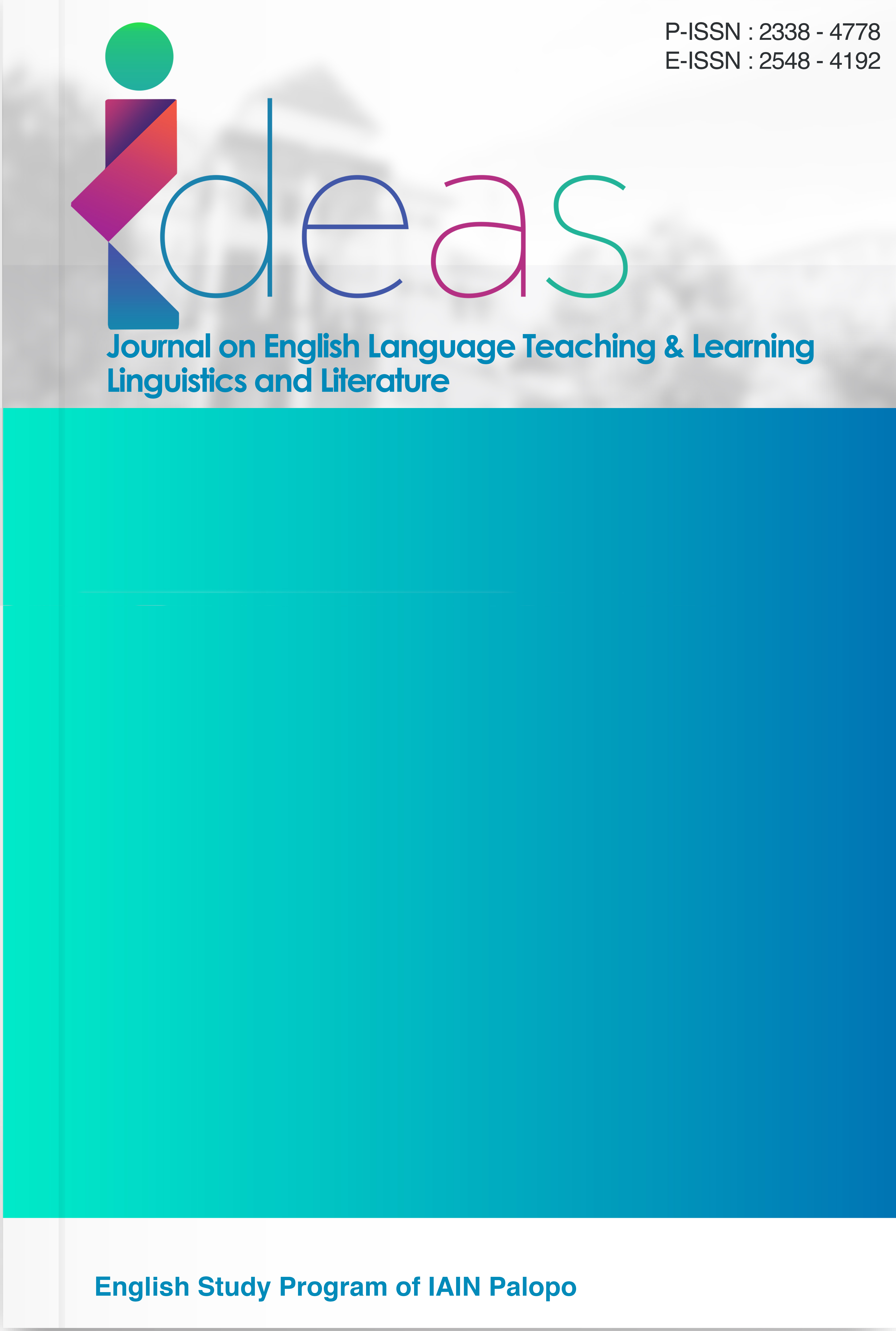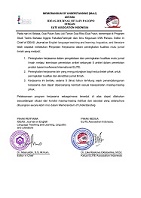Enhancing Critical Media Ethics in EFL Classrooms through Fake News Deconstruction, Narrative Reframing, and Editorial Simulation
DOI:
https://doi.org/10.24256/ideas.v13i2.7352Keywords:
Critical Language Awareness, Editorial Simulation, EFL Pedagogy, Fake News Deconstruction, Media Ethics, Narrative ReframingAbstract
This study explored how integrating fake news deconstruction, narrative reframing, and editorial simulation enhanced critical media ethics in EFL classrooms. Moving beyond conventional language instruction, it positioned English learning as a site of ideological negotiation and epistemic responsibility. Thirty education students as teacher candidates in North Sumatra engaged in an eight-week task-based curriculum analyzing ethically problematic texts drawn from real-world media. Guided by systemic functional linguistics, critical discourse analysis, and appraisal theory, students rewrote distorted headlines, clarified vague attributions, and reconstructed visual-caption misalignments. Findings revealed that students developed rhetorical precision, ethical awareness, and stylistic maturity, transforming from passive consumers into critical and active media agents. By combining language learning with civic literacy, this study proposed a replicable model for ethical pedagogy in digital times, foregrounding truth-validation, genre critique, and linguistic agency as core components of 21st-century EFL education.
References
Alejandro, A., & Zhao, L. (2024). Multi-method qualitative text and discourse analysis: A methodological framework. Qualitative Inquiry, 30(6), 461–473.
Alisoy, H. (2025). Stylistic analysis of Donald Trump’s inaugural speech: Lexical, syntactic, and rhetorical features. Acta Globalis Humanitatis Et Linguarum, 2(3), 9–19.
Arwanto, H., Djatmika, D., Drajati, N. A., & Putra, K. A. (2024). Moral values representation through speech acts in Indonesian EFL textbooks: A critical discourse analysis. JEELS (Journal of English Education and Linguistics Studies), 11(1), 51–79.
Bakry, U. S. (2025). Discourse analysis of NATO's intervention in Libya in 2011. Asian Journal of Social Sciences and Humanities, 3(4), 878–892.
Basturkmen, H. (2025). Learning a specialized register: An English for Specific Purposes research agenda. Language Teaching, 58(1), 57–68.
Chan, M. (2024). News literacy, fake news recognition, and authentication behaviors after exposure to fake news on social media. New Media & Society, 26(8), 4669–4688.
Chang, S. L., & Kabilan, M. K. (2024). Using social media as e-portfolios to support learning in higher education: A literature analysis. Journal of Computing in Higher Education, 36(1), 1–28.
Firdous, N., Ch, M. Z. A., & Ashraf, M. U. (2025). The politics of grammar: How morphosyntax is used to impose ideology in Pakistan’s legal and bureaucratic texts. Research Consortium Archive, 3(2), 668–679.
Hidayat, M. M. (2024). The 2024 general elections in Indonesia: Issues of political dynasties, electoral fraud, and the emergence of a national protest movement. IAS Journal of Localities, 2(1), 33-51.
Husnussalam, H., & Yana, Y. (2024). Rhetoric and ideology: A critical discourse analysis of Anies Baswedan’s lecturing speech at 2023 St. Lee Lecture—Can democracy deliver? Reflections on the Indonesian case. PROJECT (Professional Journal of English Education), 7(1), 124–134.
Hussain, S., Khan, A., & Zubair Iqbal, M. (2024). Media reporting of the climate change crisis in Pakistan: Identifying corrective strategies. Information Development, 40(1), 158–169.
Ismail, I., & Masruddin, M. (2023). Implementation of Smart Pop-Up Book Media to Improve Read-Write Literacy in Children. IDEAS: Journal on English Language Teaching and Learning, Linguistics and Literature, 11(1), 864-869.
Islentyeva, A., Zimmermann, E., Schützinger, N., & Platzer, A. (2024). ‘Real men score’: Masculinity in contemporary advertising discourse. Critical Discourse Studies, 21(4), 418–441.
Jaballah, N. L. (2025). Election satire: The evolution of The Daily Show as a cultural artifact reflecting democratic processes. Journalism and Media, 6(1), 18.
Jenkins, Z., & Yao, C. (2025). A critique of race-neutrality discourse among internship benefits: A critical discourse analysis. Education+ Training, 67(2), 171–183.
Jesudas, R. (2025). Transitivity analysis in Allende's And of Clay Are We Created: Language, emotion, and social commentary. Journal of Applied Linguistics, 4(2), 75–89.
Juliana, I. W., Suarka, I. N., Putra, I. N. D., & Suardiana, I. W. (2025). Reclaiming female subjectivity: Intertextual transformation from Balinese Kidung Jerum Kundangdia to novel Jerum. International Journal of Multidisciplinary Sciences, 3(2), 152–163.
Lu, C., Hu, B., Bao, M. M., Wang, C., Bi, C., & Ju, X. D. (2024). Can media literacy intervention improve fake news credibility assessment? A meta-analysis. Cyberpsychology, Behavior, and Social Networking, 27(4), 240–252.
Makhloufi, I. B. M. (2025). A critical discourse analysis of modality in COVID-19 speeches: A systemic functional grammar perspective. Jordanian Educational Journal, 10(1), 331–353.
Messaoudene, L. R. (2025). Intertextuality analysis of the “Deal of the Century” in The Washington Post and Ad-Dustour newspapers. Jordanian Educational Journal, 10(2), 276–296.
Metila, R. A., Morallo, A. B., & Zara, N. O. (2024). Discourse analysis of news frames in Philippine banner stories on COVID-19: Implications for media and information literacy during crises. Media Asia, 51(1), 81–101.
Muhhit, A. A. (2025). Lexical and grammatical meanings in selected The Jakarta Post headlines: Semantic analysis. JULIET: Journal of English Language and Literature, 2(1), 12–21.
Nanavaratorn, N. (2025). Evaluative language in US presidential media coverage: An appraisal analysis and its pedagogical implications for ELT. International Journal of Sociologies and Anthropologies Science Reviews, 5(3), 553–566.
Nguyen, D., & Hekman, E. (2024). The news framing of artificial intelligence: A critical exploration of how media discourses make sense of automation. AI & Society, 39(2), 437–451.
Putland, E., Chikodzore-Paterson, C., & Brookes, G. (2025). Artificial intelligence and visual discourse: A multimodal critical discourse analysis of AI-generated images of “Dementia.” Social Semiotics, 35(2), 228–253.
Qadees, A., Ali, Z., & Qasim, H. M. (2025). Emotion across modes in Bol: A multimodal SFL analysis of English subtitles. Journal of Development and Social Sciences, 6(2), 401–413.
Qowim, A., & Degaf, A. (2024). Kanjuruhan tragedy in The New York Times: A critical discourse analysis. Indonesian Journal of Applied Linguistics, 13(3), 468–476.
Rasheed, H., Randazzo, C., Dreier, M., & Careem, A. (2025). Abortion salience after the Roe v. Wade leak: A computational content analysis of tweets by CNN, Fox News, and ABC News. Journal of Broadcasting & Electronic Media, 69(1–2), 134–153.
Riduansyah, R., Maella, N. F. S., & Prasetyo, I. J. (2024). Critical discourse analysis on women politicians during the 2024 election. Jurnal Scientia, 13(03), 193–203.
Saad, M. (2025). Reassessing critical media discourse analysis. The Arab Journal of Media and Communication Research (AJMCR), 2025(49), 6–7.
Sadaf, S., & Iftikhar, S. (2025). Satire as resistance: A postcolonial analysis of power and corruption in A Case of Exploding Mangoes. Journal for Current Sign, 3(2), 98–108.
Saidova, M. U., & Tursunova, S. (2024). A functional-discursive analysis of lexical, syntactic, and syntactic-stylistic devices in English media discourse. Excellencia: International Multi-disciplinary Journal of Education, 2(11), 536–540.
Santikul, B. (2024). The building blocks of language and creativity: A multimodal critical discourse analysis of toy advertisements. Journal of Language Teaching and Research, 15(2), 383–395.
Schmidt, P. G., & Meir, A. J. (2024). Using generative AI for literature searches and scholarly writing: Is the integrity of the scientific discourse in jeopardy? Notices of the American Mathematical Society, 71(1), 93–104.
Smirnova, E. A., & Pérez‐Guerra, J. (2025). Do formal stance strategies reveal disciplinary variation in professional scientific writing? International Journal of Applied Linguistics.
Stamboliev, E., & Christiaens, T. (2025). How empty is trustworthy AI? A discourse analysis of the ethics guidelines of trustworthy AI. Critical Policy Studies, 19(1), 39–56.
Stamps, D. L. (2024). The nexus between Black media consumers’ racial identity, critical and digital media literacy skills, and psychological well-being. Information, Communication & Society, 27(1), 56–72.
Stevani, M. (2024). Connecting world lexicons: Figurative language’s role in BBC News listening for intercultural competence. LETS: Journal of Linguistics and English Teaching Studies, 5(2), 118–129.
Stevani, M., Yanti, N., Hidayat, I. M., Laia, F. D., & Halawa, A. I. (2024). Developing interactive multimedia-based ESP to improve English proficiency and career guidance at UPMI Medan. English Review: Journal of English Education, 12(3), 893–896.
Taghizadeh, M., & Gholami, F. (2025). Visual climate change communication in Iran’s social media: A discourse analysis of X. Journal of Cyberspace Studies, 9(2), 337–354.
Tamboer, S. L., Vlaanderen, A., Bevelander, K. E., & Kleemans, M. (2024). Do you know what fake news is? An exploration of and intervention to increase youth’s fake news literacy. Youth & Society, 56(4), 774–792.
Thamae, L., & Lihotetso, G. M. (2024). Critical literacy sustainability: What pedagogical practices? Whose role? Discourse and Communication for Sustainable Education, 15(2), 115–130.
Varkey, K., Sharma, K. K., & Basak, S. (2025). Authorial intention enunciating through Bakhtin’s heteroglossia. Cuestiones de Fisioterapia, 54(4), 7674–7681.
Wang, J., & Yin, J. (2024). The interpersonal meaning analysis of children’s language-learning-focused picture books: From a multimodal discourse analysis perspective. Open Access Library Journal, 11(6), 1–20.
Wu, D. (2024). Exploring digital literacy in the era of digital civilization: A framework for college students in China. Information Services and Use, 44(2), 69–91.
Yousaf, L., & Ahmed, H. N. (2025). Social media users’ attitude toward the madrassa community: A critical discourse analysis. Journal of Applied Linguistics and TESOL (JALT), 8(1), 1116–1129.
Downloads
Published
Issue
Section
Citation Check
License
Copyright (c) 2025 Margaret Stevani, Alexander Adrian Saragi, Oktaviana Maria Fatima Queiros Bobe, Happy Kusuma Wardani

This work is licensed under a Creative Commons Attribution-ShareAlike 4.0 International License.
Authors retain copyright and grant the journal right of first publication with the work simultaneously licensed under an Attribution-ShareAlike 4.0 International (CC BY-SA 4.0) that allows others to share the work with an acknowledgement of the work's authorship and initial publication in this journal.
Authors are able to enter into separate, additional contractual arrangements for the non-exclusive distribution of the journal's published version of the work (e.g., post it to an institutional repository or publish it in a book), with an acknowledgement of its initial publication in this journal.
Authors are permitted and encouraged to post their work online (e.g., in institutional repositories or on their website) prior to and during the submission process, as it can lead to productive exchanges, as well as earlier and greater citation of published work (See the Effect of Open Access)




